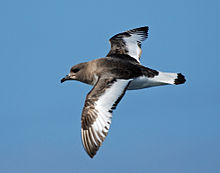Thalassoica
| Antarctic petrel | |
|---|---|
 |
|
| Scientific classification | |
| Kingdom: | Animalia |
| Phylum: | Chordata |
| Class: | Aves |
| Order: | Procellariiformes |
| Family: | Procellariidae |
| Genus: |
Thalassoica L. Reichenbach, 1853 |
| Species: | T. antarctica |
| Binomial name | |
|
Thalassoica antarctica (J. F. Gmelin 1789) |
|
The Antarctic petrel (Thalassoica antarctica) is a boldly marked dark brown and white petrel, found in Antarctica, most commonly in the Ross and Weddell seas. They eat Antarctic krill, fish, and small squid. They feed while swimming but can dive from both the surface and the air.
The Antarctic petrel is the only known species in the genus Thalassoica, and is a member of the family Procellariidae, and the Procellariiformes order. Also, this petrel along with the snow petrel, the Cape petrel, both giant petrels, and the two species in the Fulmarus family, are considered to be a separate group from the other Procellariidae members. They share certain identifying features. First, they have nasal passages that attach to the upper bill called naricorns. Although the nostrils on the petrels are on the top of the upper bill. The bills of Procellariiformes are also unique in that they are split into between seven and nine horny plates. On petrels, one of these plates forms the hooked portion of the upper bill. They produce a stomach oil made up of wax esters and triglycerides that is stored in the proventriculus. This can be sprayed out of their mouths as a defence against predators and as an energy rich food source for chicks and for the adults during their long flights. Finally, they also have a salt gland that is situated above the nasal passage and helps desalinate their bodies, due to the high amount of ocean water that they imbibe. It excretes a high saline solution from their nose.
...
Wikipedia

